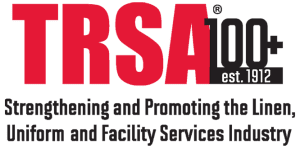APIC Attendees Support Hygienically Clean Stance on Uniforms in Public

Linen, uniform and facility services operators that are certified as Hygienically Clean Healthcare presented evidence on June 13 to members of the Association for Professionals in Infection Control and Epidemiology (APIC) that medical care facilities should more carefully control public the wearing of employee uniforms.
Engaging visitors to the Hygienically Clean exhibit at APIC’s 2018 expo, certification staff had a receptive audience for the data. Most attendees interviewed indicated they support preventing employees from wearing scrubs and other healthcare apparel outside medical facilities. Many said they have policies to this effect but find these difficult to enforce.
The 3-day APIC exhibit builds awareness of Hygienically Clean certified providers among infection preventionists: individuals who recommend what linen and uniform service their facilities should use. Discussing issues with them such as uniform hygiene positions certified operators as the foremost laundry science experts with an unprecedented commitment to educating healthcare professionals regarding linen and laundry.
Visitors to the Hygienically Clean exhibit received Curbing the Infection Risks of Healthcare Garments, a brief compendium of studies and journal articles that point to the risk-reduction value of professionally laundering employees’ garments, worth the additional cost to a healthcare facility that currently makes employees responsible for washing them.
Hygienically Clean staff noted that TRSA, the global association for the linen and uniform industry that administers the certification program, has begun planning to raise the issue’s profile with healthcare industry stakeholders. TRSA’s Healthcare Committee has formed a task force on the matter. Staff has contacted TRSA associate members (suppliers to the industry) who manufacture scrubs, lab coats and other healthcare employee garments to explore promoting a new voluntary standard that would urge medical providers to prevent wearing these in public.
An Association of Perioperative Registered Nurses (AORN) standard currently performs this role regarding garments worn in surgical suites. TRSA will weigh the possibility of supporting creation of a much broader measure, covering all clinical functions with discernible risk of pathogen transmission from healthcare garments to patients and the public.
The Hygienically Clean research compendium quotes healthcare stakeholder groups including APIC, AORN, American Association of Nurse Anesthetists, Association of Surgical Technologists and Society for Healthcare Epidemiology of America. Access this document at www.trsa.org/scrubhelp.
As TRSA investigates courses of action, hoping to involve such stakeholder groups, Hygienically Clean certified providers will continue to point to the mounting evidence of the risks of garments carrying pathogens out of healthcare facilities and inadequate domestic laundering bringing them in.
In contrast, contracting with a Hygienically Clean provider, whose processes (laundry practices) are verified and outcomes (product cleanliness) are quantified by third parties, provides maximum confidence that all garments used in a healthcare setting have diminished presence of harmful bacteria. It’s a cost-effective way to essentially eliminate this single risk of infection transmission, unlike so many others that require preventionists to constantly guard against.
